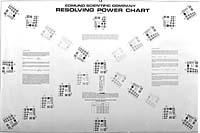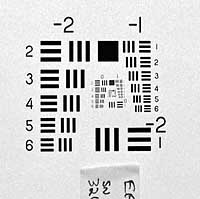 Edmund Scientific Lens Resolution Chart |
 Detail of USAF 1951 test pattern |
Method Note 1
Resolution tests were run at variable working distances from the target. An Edmund Scientific lens resolution chart was illuminated with a monolight flash adjusted with a flash meter at each aperture exposure. The lenses were mounted on a Bogen 3033/Arca Swiss B1 tripod/head combination with a large Kirk bean bag weighing down the tripod/head to dampen vibration. Two exposures at 1/250th second were taken at each aperture with an EOS-1n via cable shutter release on Kodak Technical Pan film rated at ISO 25 and developed in Technidol. The central autofocus point was centered over the center pattern for each exposure. No focus bracketing was used. After several previous tests, it was determined that camera autofocus function yielded consistently higher lpm scores than trying to use manual focus and bracketing with an eyepiece magnifier. The lens was manually defocused, and then refocused using autofocus for each exposure. Line patterns were read under a compound brightfield microscope at a magnification of 40X.
Measurement were made at the center pattern, a middle pattern, and the far upper right pattern on the two exposures. The highest resolution score for each aperture was recorded to minimize the the effect of potential autofocus error (The standard deviation in autofocus tests with an EF 300mm f/2.8 lens was calculated as 5.9% [4.96 lpm]). Center-weighted resolution was calculated (60% center; 30% middle; 10% edge). Resolutions (lpm) at each f/stop were calculated using the method on the chart as follows.
Image lines pairs per mm (image lpm or lp/mm) = lpm resolved on chart X (D-fo) / fo) where fo = focal length of lens and D = Distance from the chart to the middle of the lens.
Tests on the IS and non-IS versions of the lens were run at the same time under identical conditions at 70mm and at 85mm. For tests at 135mm and 200mm, tests were run under identical conditions. However, IS data was compared with historical non-IS lens data developed when I was running tests on the EF 135mm f/2 L and the EF 200mm f/1.8 L lenses. The EF 85mm f/1.8 lens data is from a previous test run under identical conditions.
The IS lens was a brand new Canon USA version of the lens right out of the box. The non-IS lens was my trusty used imported version (purchased in 1998) in excellent condition (8.5 cosmetic on a 10 scale).
Technique note added after initial posting of review: Several readers expressed concern that I was using a damaged or bad sample of the IS lens, and reports were posted on dpreview.com that bad samples of this lens have been found after purchasing the lens new. I exchanged my new lens for a second sample of the new lens at my dealer. The 2nd new copy came out of the box with all of the plastic wrappers in factory folded condition. I tested the second new lens in identical manner except that I used an EOS-1v camera and took 3 exposures at each aperture setting. The highest lp/mm values were used. Resolution curves of the second lens could be superimposed upon those of the first new lens within the range of measurement variation.
 Edmund Scientific Lens Resolution Chart |
 Detail of USAF 1951 test pattern |